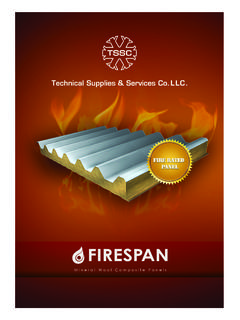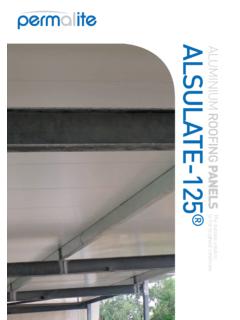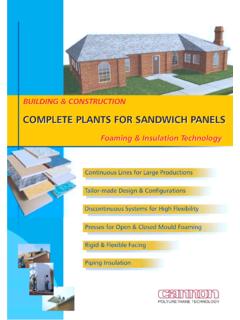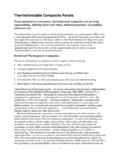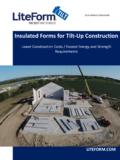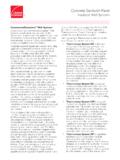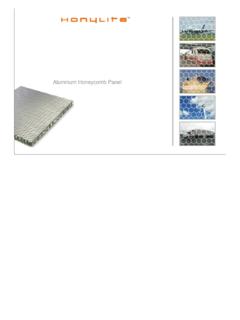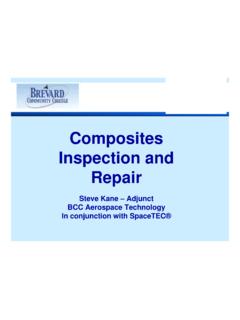Transcription of RESEARCH REPORT 039 - Health and Safety Executive
1 HSE Health & Safety Executive The cost effective use of fibre reinforced composites offshore Prepared by the University of Newcastle Upon Tyne for the Health and Safety Executive 2003 RESEARCH REPORT 039 HSE Health & Safety Executive The cost effective use of fibre reinforced composites offshore Professor A G Gibson Centre for Composite Materials Engineering University of Newcastle Upon Tyne Newcastle upon Tyne NE1 7RU United Kingdom The results of a major RESEARCH programme into the cost effective use of fibre reinforced composites offshore, undertaken as a Joint Industry Project by a consortium of universities and contractors are presented in this REPORT . The REPORT includes a detailed (54 page) summary of current offshore composite applications, followed by a review of the 43 projects conducted during the programme which spanned 13 years and four phases of RESEARCH and considered the following performance issues fire, blast/impact, environmental durability, elevated temperatures, jointing, long term behaviour, non-destructive inspection and structural design.
2 These are related to the use of pipes, panels, secondary structures gratings, walkways etc. and top-side structures. The REPORT is intended for use as an information source for engineers involved in the use of composites offshore. The most significant advances have been in the areas of pipework and fluid handling, driven by their light weight and corrosion resistance compared to metals. Until recently, interest focussed on the use of glass fibre-based composites and on the topsides of offshore platforms. However, the prospect of deepwater production is generating a new impetus for high performance composites for demanding subsea applications. The probable scale of some new subsea developments, such as rigid risers and tethers is likely to result in greatly increased demand for carbon based composites as well as for the manufacturing facilities to process them. Composite down-hole tubing is also beginning to find applications subsea and in well intervention.
3 The original barriers to the use of composites offshore were regulatory requirements, lack of design information and the fragmented structure of the composites industry. The project has made significant progress in their removal, as well as generating increased awareness of the major economic, Safety and environmental benefits that a wider use of composite materials can bring. The Composites Offshore programme provided valuable underpinning information for a number of applications, including glass reinforced plastic (GRP) piping, offshore structures, repair systems and composite fire protection of the oil and gas industry. This REPORT and the work it describes were funded in part by the Health and Safety Executive (HSE). Its contents, including any opinions and/or conclusions expressed, are those of the authors alone and do not necessarily reflect HSE policy. HSE BOOKS Crown copyright 2003 First published 2003 ISBN 0 7176 2591 5 All rights reserved.
4 No part of this publication may be reproduced, stored in a retrieval system, or transmitted in any form or by any means (electronic, mechanical, photocopying, recording or otherwise) without the prior written permission of the copyright owner. Applications for reproduction should be made in writing to: Licensing Division, Her Majesty's Stationery Office, St Clements House, 2-16 Colegate, Norwich NR3 1BQ or by e-mail to ii CONTENTS 1. INTRODUCTION 1 2. SUMMARY OF APPLICATIONS 3 3. PIPES, TANKS AND VESSELS 7 Composite Pipework 7 Joining techniques 8 Steel strip laminate (SSL) pipe 10 Mechanical behaviour and failure modes 10 Applications 11 Tanks and Vessels 14 Flexible Thermosetting Tube 15 Reinforced Thermoplastic Pipe (RTP) 16 Lined Pipe 17 Rigid Risers 18 Flexible Risers 19 High Pressure Accumulator Bottles 20 Repair of metallic tubulars 21 4. STRUCTURAL APPLICATIONS 25 Blast and Fire Protection 25 Gratings and Stairways 27 Tethers and Tendons 27 5.
5 MAJOR LOAD-BEARING STRUCTURAL USE OF COMPOSITES OFFFSHORE 29 Designers and Fabricators 31 Composites Industry Infrastructure 32 Scale-up of Fabrication Processes 32 6. RELEVANT PROPERTIES OF COMPOSITES 33 Environmental and Fatigue Behaviour 33 Fire Performance 35 Fire Reaction 36 Fire Resistance 39 Jet Fires Tests 39 iii 7. CONCLUSIONS 39 8. REFERENCES 43 iv 1. INTRODUCTION This REPORT reviews areas where composites are finding application in the oil and gas industry, onshore and offshore. The most significant advances have been made in the areas of pipework and fluid handling, driven by light weight and corrosion resistance compared to metals. Modest, but significant progress has also been made in structural applications. Lessons are being learned from successful applications with the result that operators, design houses and contractors are now beginning to take a serious interest in their wider use.
6 Expansion is therefore expected to continue into all sectors of the oil and gas industry. RESEARCH results and new developments have been summarized in a number of references (ARP, 2000; Composite Materials for Offshore Operations: Proceedings of the First International Workshop , 1993; Croquette, 1994; Gibson, 1993, 2000, 2001; Institut Fran ais du P trole, 1994; Salama, 1995 and Wang et al. (1999, 2000)). Until recently, interest has focused on the use of glass fibre-based composites in onshore fluid transport and on the topsides of offshore platforms. However, the prospect of deepwater production is generating a new impetus for high performance composites for demanding sub sea applications. The probable scale of some new sub sea developments, such as rigid risers and tethers (see Sections and ) is likely to result in greatly increased demand for carbon based-based composites as well as for the manufacturing facilities to process them.
7 Composite down-hole tubing is also beginning to find applications sub sea and in well intervention (Section ). In many cases the purchase cost of composite components exceeds that of their metallic counterparts. However, because of their relative ease of handling the installed cost, especially of pipe systems, is often lower than that of conventional steels. The cost advantages are even greater when composites replace expensive corrosion-resistant metals such as copper-nickel alloys, duplex or super duplex stainless steel or even titanium. Their corrosion resistance also improves reliability and leads to lower through-life costs. As well as expected benefits, a number of barriers to the use of composites offshore were identified in the 1980 s. These were: 1. Regulatory requirements, especially on combustibility 2. Lack of relevant performance information, especially in hostile offshore environments (including erosion, fatigue, wear and impact abuse, as well as fluid environments).
8 3. Lack of efficient design procedures and working standards, combined with unfamiliarity on the part of designers 4. The fragmented structure of the composites industry, and 5. Difficulty of scaling up fabrication processes to make very large composite structures The majority of RESEARCH undertaken on offshore composites in the last two decades has been aimed at the removal of barriers 1-3, and much has been achieved, especially in the regulatory area where prescriptive requirements have been largely replaced by performance-based or goal-setting ones. Some remaining problems associated with infrastructure and process technologies will be discussed in Section 1 2 2 SUMMARY OF APPLICATIONS The most successful offshore applications for composites have been in pipework for aqueous liquids. Performance-based guidelines for the design of glass fibre reinforced epoxy (GRE) pipes have significantly accelerated these applications.
9 These were initiated by UKOOA (United Kingdom Offshore Operators Association (1994) and has recently resulted a draft ISO standard (ISO 2000). Another important application is in panelling for both floors and walls. The first significant tonnage on a North Sea platform involved fire protection panels for the heli-deck of the Amerada Hess Rob Roy rig, Figure 1, which was deployed in the 1980s. It is interesting to note that, despite their perceived combustibility, many of the early uses of GRP offshore involved applications where response to fire was an important issue. Figure 1 The first major application of composites in the North Sea. Helideck fire protection on the Amerada Hess Rob Roy rig in the early 1980 s (Courtesy of Vosper Thornycroft (UK) Ltd. The types of glass based-based composite most often used in structural applications are compared in Table 1.))
10 Besides cost, the most important issues relating to materials selection are smoke and toxicity in fires and, of course mechanical properties, including resistance to impact and adverse environments. It can be seen that the most 3 important structural materials, epoxy, vinyl ester and polyester, would probably be prevented from use in areas where smoke and toxicity would be a problem (Gibson, 2001). The most favourable systems from the viewpoint of toxicity are those based on phenolic resins. Modified acrylic resins, such as Modar, may also be used in certain toxicity-sensitive areas, but this resin type has yet to be widely used offshore. Two small-scale platforms, Figure 2, deployed in shallow water by Amoco UK (now BP-Amoco) are excellent examples of the use of composites in offshore structures. Low cost and ease of transport were important features in their design, and achieving minimum topside weight was clearly important because of their monopod construction.










